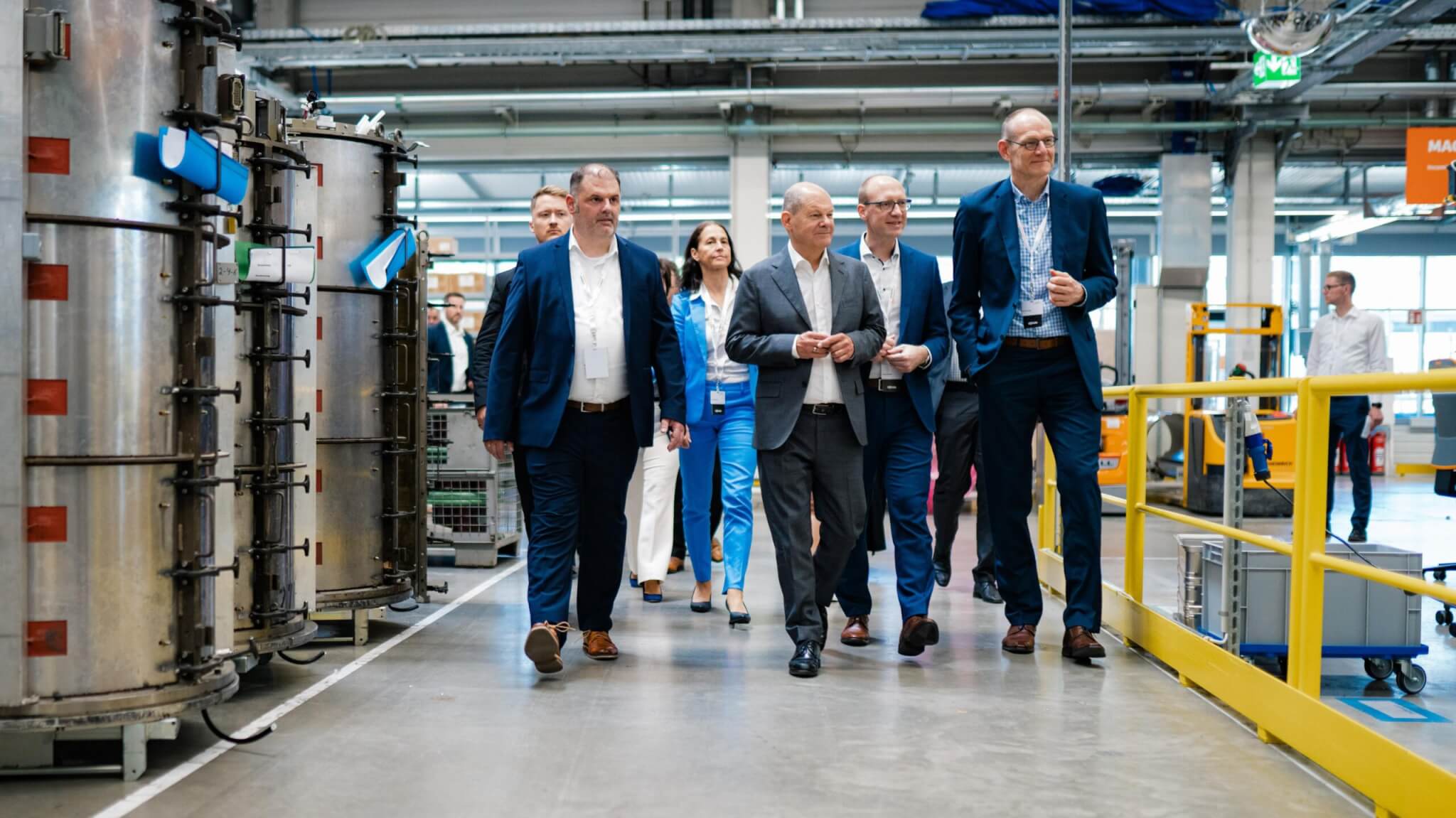Germany is often described as the “economic locomotive of Europe”. A country with huge industrial potential, strong research, a highly skilled and well-paid workforce, a world export power. It is also the Czech Republic’s primary partner, but in recent years, for a number of reasons, it has run into serious problems. The locomotive has lost steam and economic recovery is nowhere in sight.
Germany’s economic growth is stalling, the country is stumbling. It was the only country in the G7 to record a year-on-year decline in gross domestic product (GDP) last year, and it is again the worst performer in this club this year. The governing coalition in Berlin, made up of the Social Democrats (SPD), Greens and Free Democrats (FDP), has been wracked by internal divisions over the budget, energy, migration and other issues since its inception. That is why it has also failed to push for key changes – to ease the tax burden, to simplify the tangled bureaucracy, to set key investment priorities.
The government’s failure to take effective action on the domestic political scene plays into the hands of extremists, primarily the right-wing populist Alternative for Germany (AfD). Ahead of upcoming elections in three East German states, its preference in the former GDR is above 30 percent. This is worrying for companies in Germany and for foreign investors, and raises questions about how stable and trustworthy the country will be.
Balancing on the brink of recession
The leading German economic research institutes stated in a joint report earlier this year that “the economy is moribund”, while at the beginning of the summer some of them said that “this year’s recovery will be only gradual”. But then came the preliminary report from the Federal Statistical Office at the end of July, according to which the recovery is not even gradual. GDP fell by 0.1 per cent in the second quarter compared with the previous three months and by the same amount year-on-year.
The other major eurozone economies are much better off in terms of growth rates this year.
If German GDP falls again in July-September compared with the negative second quarter, the German economy will enter a so-called technical recession, which may not yet mean a deep downturn, but it will certainly mean a downturn.
“A solid quarter-on-quarter rise of more than half a percent was last calculated by German statisticians about two years ago. For some time now, everything has been pointing to the fact that Germany is not just in an unfavourable business cycle, but that many of the causes of its economic weakness are structural in nature,” says Michael Hüther of the Cologne-based Institute for Research on the German Economy.
“The causes of Germany’s economic weakness are structural.”
The federal government and many economists are counting on a year-on-year GDP growth of only 0.2 percent in Germany this year, but even this modest figure is not certain. “The economic data so far cast doubt on this,” Clemens Fuest, president of the Munich-based IFO Institute for Economic Research, said on the Handelsblatt Today podcast.
Unemployment on the rise
Even this year, some four years after the worst of the coronavirus pandemic had passed, domestic demand has not fully recovered. German consumers are still clutching their wallets. They are spending prudently, which is reflected in the rising household savings rate. Their spending this year remains around two per cent below the pre-pandemic level of 2019.
Meanwhile, real wages rose by a strong 3.8 percent year-on-year in the first quarter of this year, according to the Federal Statistical Office. This was mainly due to one-off payments (the so-called inflation premium). Without them, real wages would have remained below the level of 2019.
The overall level of consumer prices in Germany is now about one-fifth higher than it was before the pandemic in 2019.
Private consumption and household consumer sentiment are strongly influenced by developments in the labour market. The authorities recorded 2.8 million unemployed at the end of July. The last time there were that many was in November 2020. The average unemployment rate rose by 0.2 percentage points to a flat six percent against 5.7 percent a year ago.
“The weak economic development is also having a negative impact on the labour market. The unemployment rate has risen more than usual ahead of the summer holiday period,” commented Daniel Terzenbach of the Federal Employment Agency (BA). According to him, there are also more people employed intermittently, on a casual basis. German statistics record them under the heading “Unterbeschäftigung”. At the end of July, there were almost 3.6 million such people officially, 139,000 more than a year ago.
“The average unemployment rate rose by 0.2 percentage point in July to an even six per cent, up from 5.7 per cent a year earlier.”
For example, ZF Friedrichshafen, Germany’s second-largest supplier of automotive and other components after Bosch, has announced extensive redundancies for the coming years. It plans to cut between 11,000 and 14,000 jobs at its German factories by the end of 2028.
At the same time as announcing job cuts at home, ZF is investing half a billion dollars to upgrade its plant in Gray Court, South Carolina, USA, to produce a new generation of powertrains for passenger cars. For example, an eight-speed automatic transmission, also suitable for plug-in hybrids. The investment will create several hundred jobs – but not in Germany.
Industry lacks orders
One of the reasons why more people are out of work is the growing number of corporate insolvencies. According to the Institute for Economic Research in Halle, East Germany (IWH), 1,169 bankruptcies were reported in Germany at the end of June, 11 percent more than at the same time a year ago and almost a quarter more than the average for 2016-2019.
Indebted companies are paying the price for a noticeably weakening inflow of new orders, so their “cushion” is thinning. “We are experiencing a really bad start to the second half of the year,” Cyrus de la Rubia, chief economist at Hamburg-based Commercial Bank, said.
Meanwhile, several leading indicators valid for the entire German economy have turned negative. These include the business confidence index surveyed every month by the Munich-based IFO in industry, construction, services and trade. This is an indicator that is monitored by the entire European Union, given Germany’s economic weight.
This index headed slightly upwards at the beginning of this year, but its value has been deteriorating since April. In July, it fell to 87 points against 88.6 in June and 89.3 in May.
“Corporate insolvencies are on the rise.”
The index, surveyed in approximately 7,000 companies, has two components. Managers assess both the current situation and the prospects for the next six months (order backlog, capacity utilization, employment, inventory development and other indicators).
In the July survey, German industrial firms mainly painted their current situation in dark colours. Their order backlog has thinned again, with production capacity utilisation averaging 77.5 per cent, which is six percentage points lower than the long-term average for German industry.
The situation in the car industry is particularly difficult
This is doubly true for the car industry. “This sector is slipping deeper and deeper into crisis,” commented Anita Wölfl, who is responsible for this sector at the Munich-based IFO.
In her opinion, no significant improvement can be expected in the coming months. Production capacities in the German car industry are on average 77.7 percent utilised, which is nine percentage points below the long-term average. More than two-fifths of companies (43.1 percent) complain of a lack of orders (29 percent in April). Their export expectations are also at a very low level.
2.1 million passenger cars rolled off the production belts of German carmakers between January and June this year, down six percent year-on-year and even 16 percent compared to the first half of the pre-pandemic year 2019.
Exports fell by two percent to 1.2 million passenger cars this year, according to the latest statistics from the Association of the German Automotive Industry (VDA).
Earlier this summer, the VDA revised its forecast for electric car production this year. It should increase by five percent compared to last year to 1.33 million vehicles, of which around one million will be fully electric vehicles (BEVs). In the spring forecast, it had envisaged a 16 per cent increase to a total of 1.47 million units. The significant downward revision is mainly due to unexpectedly low BEV production.
The development in the subcontracting sector is of great concern. During the first half of this year, 20 companies with an annual turnover of over EUR 10 million declared bankruptcy, compared with a dozen in the comparable period last year. More than 10,000 jobs are at stake, according to a report by the consultancy Falkensteg, to which the trade magazine Automobilwoche refers.
Risk of deindustrialisation
Expensive energy, lack of skilled labour and lengthy approval procedures are the main reasons why Germany has suffered from a long-term outflow of direct investment. Companies there prefer to shift part of their production abroad, mainly to the US, but also to Southeast and South Asia.
The country has also lost its attractiveness in the eyes of foreign investors, which is confirmed by the statistics characterising the net outflow of their direct investment. “The recurring outflow shows that this is not a random phenomenon but the first sign of imminent deindustrialisation,” said Christian Rusche of the IWH.
“The country has lost its attractiveness even in the eyes of foreign investors.”
According to a recent report by the institute, Germany attracted foreign direct investment worth just €22 billion last year. This figure includes investment in the expansion or modernisation of existing capacities and greenfield construction, and does not include capital invested in corporate mergers and acquisitions.
“Politicians do not create good conditions for investment. Numerous support programmes have been cancelled overnight under the pressure of budget problems. If the political framework conditions do not improve, the process of de-industrialisation will accelerate significantly,” warns Rusche in the Frankfurter Allgemeine Zeitung.

Chancellor Olaf Scholz visiting one of Germany’s major medical technology companies, Siemens Healthineers, in July this year: Siemens Healthineers
Kerstin Andreae, head of the Federal Association of Energy and Water Management (BDEW), is also critical of the government’s investment policy. If the “Energiewende” (energy transition without nuclear power and, in the future, coal) is really to take hold in Germany, huge investments are necessary. The association estimates this at €721 billion by 2030 and even €1.2 trillion by 2035. Otherwise, it will be impossible to meet the long-term climate targets. “It’s not just about massive construction of solar and wind parks, but also grids and hydrogen capacity,” Andreae pointed out. She said the state in particular needs to invest massively in this sector, with private capital only a complement. However, she does not say where the state should get the resources from.
Pharmaceutical production as a bright spot?
One of the few bright spots on the German economic scene is the development of the pharmaceutical industry, which has long been increasing production, value added and employment and attracting foreign capital. The latest major project in this area was announced by the French Sanofi group, which is investing €1.3 billion in new capacity in Frankfurt am Main, where it has been producing insulin since 2005.
At the beginning of April this year, the US company Eli Lilly laid the foundation stone for the construction of a new €2.3 billion plant in Alzey (Rhineland-Palatinate). It plans to produce both diabetes and weight-loss products there.
The Federal Government understandably welcomes this and hopes that the investment in pharmaceuticals will be followed by projects in other sectors. It already has several examples at hand. In February this year, the US-based Intel applied for permission to build two giant chip factories in Magdeburg (Saxony-Anhalt). It has already confirmed its investment plan, worth up to EUR 30 billion (of which the German state will contribute around EUR 10 billion), at the end of March 2022.
However, it is not 100% certain that the megaproject will come to fruition. Intel has fallen into deep losses and intends to cut up to 15,000 jobs worldwide. “Will the new factories it is planning in eastern Germany even be needed anymore?” asks the German media a suggestive question.
The €10 billion project near Dresden, Saxony, is being planned by Taiwanese chipmaker TSMC (announced last August) together with three partners. In February, US-based Microsoft said it would invest €3.2 billion over two years in Cologne for cloud services and infrastructure needed to develop artificial intelligence. The latest to announce a large-scale project was the US Amazon at the end of June, which plans to invest up to €10 billion in cloud and other internet services in Germany over time.
Based on these facts, the government support company GTAI (Germany Trade & Invest) has also concluded that Germany, despite its poor economic growth, expensive energy, high tax burden and rampant bureaucracy, is once again enjoying the confidence of foreign investors.
Critical voices, however, point out that Germany has long lacked a regular flow of foreign investment into smaller projects, and a few mammoth plans cannot make any significant difference.
Contact
Next articles and interviews
Next articles and interviews
+ Show









